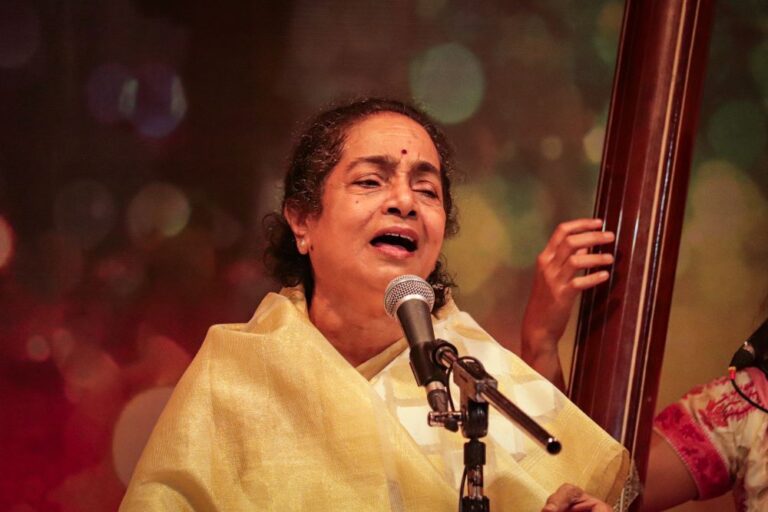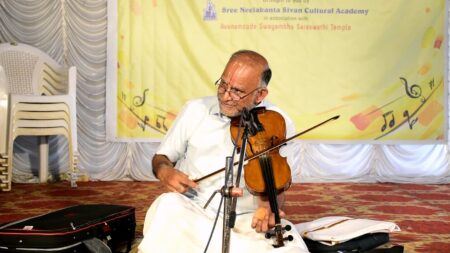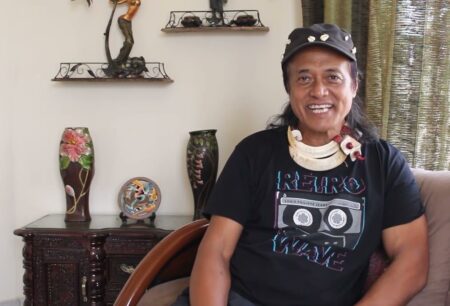Shruti Sadolikar’s recent Thumri concert at Delhi’s Kamani Auditorium extracted the required ‘rasa’ from the raga in its pure form.
Thumri is perhaps one of the most challenging forms of Hindustani classical music. Possibly no other genre has covered so much of musical forms—ranging from folk songs, including ‘birahas,’ to seasonal songs like ‘chaitis’ (sung during spring or ‘chaitra’), ‘kajris,’ ‘jhoolas,’ ‘savanis’ (sung during the rains), to festive songs like ‘horis’ (sung during Holi), ‘dadras’ (so-called because of the ‘taal’ they are composed in), ‘baarahmaasi,’ or those sung all year round—Thumri has it all.
Yes, the great musicians of yesteryear acknowledged that not everyone could sing a Thumri. At the late Naina Devi’s house, where informal soirees were the norm whenever a musician passed through Delhi, Ustad Bade Ghulam Ali Khan asked the great Rasoolan Bai to teach him this musical form! Today, Bade Ghulam Ali Khan’s brand of Punjabi Thumri is emulated ardently; but he himself acknowledged the greatness of Banaras, Purab ang Thumri. Apparently, Rasoolan Bai folded her hands in humility and laid her head on the maestro’s knee as a gesture of respect, saying, “Bhai, jo tum kar sakte ho, koi aur nahi kar sakta, ab Thumri main kya seekhaoon!”(Brother, No one else can do what you can do. What will I teach you in thumri?)
One can scarcely believe this today, when Punjab ang Thumri spearheaded by Ustad Bade Ghulam Ali Khan is so popular, but it happened. The point of the story is that even the greatest singer of the time, Bade Ghulam Ali Khan, understood that the ‘dard,’ the emotion, and pathos that a singer like Rasoolam Bai was trained to focus on, was something he, with his great command of the voice, needed to master. Today, sadly, among common perceptions, Thumris are regarded as a somewhat lesser art form.
Harmonising emotions
In Thumri, strict adherence to the grammar of the Raga is not necessary, and ‘mishra’ or mixed raga forms are permitted. This has led several non-serious practitioners to conclude that, as the genre is termed ‘light’ classical music, it is light in musical content and thus easier to sing.
It is said that Thumri evolved after khayal, in the 19th-century court of Nawab Wajid Ali Shah. However, this has been disputed by many. It would be safer to conclude that Thumri gained popularity and was distinguished as a distinct genre only around 200 years ago. Liberties with Raga can be taken, as the predominant rationale behind this type of music is to convey through words a mood or emotion. Adherence to ‘taala’ is perfunctory; great Thumri singers arrive on the ‘sam’ by instinct and never bother to count their way. Certain ragas are today regarded as best suited to Thumri – Khamach, Desh, Tilang, Pilu, Kafi, Bhairavi – as they are perceived as being more adaptable to ‘shringaar rasa’. But, in years gone by, they were sung in many more ragas.
Today, there is a perception that Thumri is best suited to a female singer, to most adequately convey the emotions of love, separation, and anguish. However, the greatest Thumri singers of this century included men – Ustad Moujjuddin Khan (1875-1926), born in Nalagarh, Punjab, who died in Banaras, and Bhaiyya Sahib Ganpatrao of Gwalior (1852-1920). Bhaiya Sahib’s father was the Maharaja of Gwalior, and his mother was a singer. He is regarded as the greatest harmonium player ever; he also was a master of Thumri. It is said that Ustad Hafiz Ali Khan, the great sarod maestro, learned Thumri from him too.
Ustad Abdul Karim Khan, founder of the Kirana gharana, Ustad Faiyyaz Khan, the great doyen of the Agra gharana, and Bhimsen Joshi were well-known for their Thumris. The great Thumri singers of the 20th century included Gauhar Jan, Jaddan Bai, Malka Jan, Badi Moti Bai, Rasoolan Bai, Siddheshwari Devi, Begum Akhtar, Naina Devi, Shobha Gurtu, and Girija Devi. The ‘adaa’ with which they embellished the compositions made their music unforgettable, even without the visuals.
Ustad Gullubhai Jasdanwallah of Mumbai, though not a great performer, was a storehouse of old compositions. He taught Shruti Sadolikar many compositions, and he also had rare recordings of the doyen of the Jaipur Attrauli gharana, Kesarbai Kerkar, singing pieces, which he shared with Shruti.
Shruti’s thumri triumph
At the recent festival held as a part of Delhi government’s Sahitya Kala Parishad Shruti paid apt tribute to her Guru, carefully choosing rare and appropriate pieces. Ustad Manjhi Khan, son of Ustad Alladiya Khan, was very fond of Thumri, and his disciple Gullubhai had picked up many compositions from him. Shruti sang one in Raga Kafi, sung in ‘tappa’ ang, appropriately in Punjabi ‘taal’ (tappa as a style originated in Punjab). “Sneh lagyo moso Sham.” Suppressing her instincts as a khayal singer par excellence, Shruti let the words flow seamlessly, conveying the overriding emotion of ‘sneh,’ love.
The second rare composition, in Raga Pilu, was by the now unknown ustad, Ghamman Khan, from whom Shobha Gurtu had also learned. Ending with a racy ‘laggi’ played by Pt Vinod Lele on the tabla, Shruti next paid tribute to another master, Janki Bai ‘Chappanchurri’ (so-called because apparently she had been stabbed 56 times by an enraged lover) with a beautiful ‘dadra’ ‘aan baan’. Shruti concluded in Raga Khamach of Begum Akhtar, ‘koyaliya’ – she said any festival of Thumri was incomplete without a tribute to this great legend. Vinay Mishra on the harmonium was in his element.
With her impeccable musical training, Shruti did not need to sing mishra ragas simply because she was singing Thumri; she extricated the required ‘rasa’ from the Raga in its pure form, underlying the fact that great Thumri requires a master to sing it.




